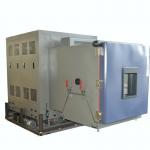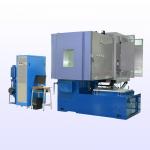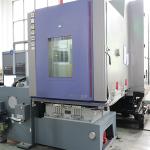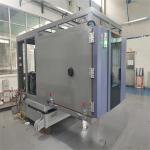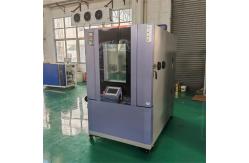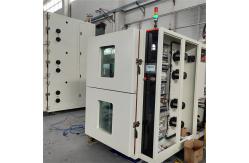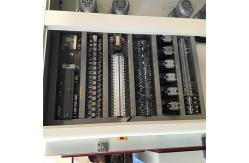In the highly demanding and safety-critical fields of aerospace and
defense, the performance and reliability of electronics are of
utmost importance. The Customized Environmental Test Chambers are
designed to subject aerospace and defense electronics to a
comprehensive range of extreme and simulated environmental
conditions, ensuring that they can withstand the rigors of their
intended applications. This specialized type of test chamber is dedicated to evaluating
the integrity and functionality of electronic components and
systems used in aerospace and defense applications. It serves
aerospace manufacturers, defense contractors, research
institutions, and military testing facilities. The primary goal is
to identify any potential weaknesses or vulnerabilities in the
electronics by replicating the harsh environmental conditions they
will encounter during their lifecycle, including extreme
temperatures, rapid temperature changes, high humidity, low
pressure, vibration, shock, and electromagnetic interference. By
conducting these tests, engineers can make informed decisions about
design improvements, material selections, and manufacturing
processes, ultimately enhancing the overall reliability and
survivability of the electronics in mission-critical operations. - Robust and Secure Construction
- The chamber is constructed with a heavy-duty, high-strength alloy
framework that can withstand the intense forces and stresses
generated during testing. The exterior is made of a
corrosion-resistant material, ensuring long-term durability and
protection against the elements. The interior is lined with a
thermally conductive and electrically conductive material to
promote uniform temperature distribution and provide
electromagnetic shielding. The door is a crucial component,
featuring a multi-point locking system and a high-quality sealing
gasket to maintain a hermetic seal, preventing any leakage of
conditioned air and protecting the internal environment from
external contaminants. A small, reinforced viewing window, made of
tempered and anti-reflective glass, allows for visual inspection
without compromising the chamber's integrity. The chamber is also
equipped with internal lighting and access ports for sensors and
instrumentation.
- Precision Environmental Control Systems
- Temperature Control: Capable of maintaining an extremely wide
temperature range, from -80°C to +200°C, with an accuracy of
±0.5°C. It utilizes advanced cryogenic cooling and resistive
heating technologies, integrated with a sophisticated feedback
control system. Multiple temperature sensors are strategically
placed throughout the chamber to ensure uniform temperature
distribution and rapid response to any temperature deviations. The
control panel allows for the programming of complex temperature
profiles, including rapid temperature ramps, extended soak times at
specific temperatures, and cyclic temperature sequences,
replicating the temperature variations experienced during different
phases of aerospace and defense operations, such as takeoff, flight
at high altitudes, and re-entry.
- Humidity Control: The humidity control system can achieve humidity
levels from 5% to 95% RH, with an accuracy of ±3% RH. It employs a
combination of steam injection humidifiers and desiccant
dehumidifiers, synchronized with a laminar flow air circulation
system. The chamber is equipped with high-precision humidity
sensors that continuously monitor the internal humidity, and the
control system makes real-time adjustments to maintain the desired
humidity levels. This is crucial for testing the effects of
moisture on electronic components, such as the potential for
corrosion, short-circuiting, or degradation of electrical
properties, especially in humid tropical or maritime environments.
- Pressure Control: The chamber can simulate a wide range of
pressures, from near-vacuum conditions (equivalent to high-altitude
flight) to several times atmospheric pressure. The pressure control
system is highly accurate, with an error margin of less than ±0.1
kPa. It uses vacuum pumps and pressure regulators to create and
maintain the desired pressure levels. This is essential for testing
the performance and integrity of electronics in aerospace
applications, where rapid pressure changes and low-pressure
environments can have significant impacts on component behavior,
such as the outgassing of materials, the performance of seals, and
the operation of pressure-sensitive devices.
- Vibration and Shock Control: The vibration system is capable of
generating a wide variety of vibration frequencies and amplitudes,
simulating the vibrations experienced during engine operation,
flight turbulence, and ground transportation. It can produce
vibrations from 2 Hz to 2000 Hz, with amplitudes adjustable from
0.1 mm to 50 mm. The shock system can deliver precise shock pulses
with adjustable magnitudes and durations, replicating the impact
forces that may occur during landing, missile launch, or combat
scenarios. The vibration and shock tables within the chamber are
designed to provide a highly uniform and controlled excitation
field, ensuring that all parts of the tested component experience
the same mechanical stress. The control systems for vibration and
shock allow for the programming of complex waveforms and sequences,
enabling the accurate simulation of real-world events.
- Electromagnetic Interference (EMI) and Compatibility (EMC) Testing:
The chamber is equipped with an advanced EMI/EMC testing system,
capable of generating and measuring a wide range of electromagnetic
fields. It can simulate the electromagnetic environment that
electronics will face in the presence of other onboard systems,
radio frequency transmissions, and potential sources of
interference. The system can measure the susceptibility of the
tested electronics to EMI and evaluate their ability to emit
electromagnetic radiation within acceptable limits. This is crucial
for ensuring the proper operation of electronics in the highly
electromagnetically congested aerospace and defense environments,
where interference can lead to system failures, loss of
communication, or incorrect sensor readings.
- Advanced Instrumentation and Data Acquisition
- The chamber is outfitted with a comprehensive suite of sensors and
instrumentation. In addition to temperature, humidity, pressure,
vibration, and EMI sensors, it includes sensors for measuring
electrical parameters such as voltage, current, resistance,
capacitance, and inductance of the tested electronics. These
sensors are connected to a state-of-the-art data acquisition system
that records and stores all relevant data. The data acquisition
system offers a high sampling rate, typically ranging from 1000 to
10,000 samples per second, ensuring that even the most rapid
changes in environmental conditions, mechanical stresses, or
electrical performance are accurately captured. The collected data
can be accessed and analyzed in real-time or retrieved later for
in-depth studies. The system is also compatible with specialized
aerospace and defense data analysis software, enabling the
generation of detailed reports and graphical representations of the
test results, which are essential for making informed engineering
decisions.
- Enhanced Safety and Compliance Features
- The Customized Environmental Test Chambers for Aerospace and
Defense Electronics are designed with multiple layers of safety
features. It incorporates an automatic emergency shutdown system
that activates immediately in the event of any critical
malfunction, such as overheating, overcooling, excessive pressure,
or a failure in the vibration or shock system. The chamber is
equipped with a fire suppression system, which can quickly
extinguish any potential fires that may occur due to electrical
faults or component failures. The ventilation system is engineered
to remove any harmful gases or fumes that may be generated during
the testing process, protecting both the samples and the operators.
The control panel is designed with safety interlocks and clear
warning indicators to prevent accidental operation and ensure the
well-being of personnel. Additionally, the chamber complies with
all relevant aerospace and defense industry standards and
regulations, such as MIL-STD-810 for environmental testing of
military equipment, RTCA/DO-160 for avionics, and various
international standards for EMI/EMC testing, ensuring that the
testing procedures are recognized and accepted by regulatory bodies
and industry stakeholders, facilitating the certification and
deployment of aerospace and defense electronics.
- Chamber Size and Capacity: The chamber is available in a variety of sizes, from small
benchtop models with a volume of a few liters, suitable for testing
individual electronic modules or small components, to large
floor-standing units with volumes up to several cubic meters,
capable of accommodating entire racks of avionics equipment or
complex defense electronics systems. The interior dimensions are
carefully designed to ensure proper air circulation, uniform
distribution of environmental parameters, and effective testing of
the samples. For example, a medium-sized chamber might have
interior dimensions of 2 meters x 2 meters x 3 meters, providing
sufficient space for testing a single satellite communication
system or a set of missile guidance electronics.
- Temperature Cycling Rate: The chamber can perform temperature cycles at a rate of 2 to 5
cycles per hour, depending on the specific requirements of the test
protocol. For example, it can rapidly cool from +120°C to -60°C in
a matter of minutes and then heat back up, subjecting the
electronics to significant thermal stress. The ramp rate can be
adjusted, typically ranging from 1°C per minute to 20°C per minute,
allowing for the simulation of different thermal profiles.
- Humidity Cycling Rate: The humidity can be cycled within 15 to 30 minutes, allowing for
the simulation of rapid changes in moisture conditions. This
replicates the transitions that may occur, for example, when an
aircraft moves from a dry, high-altitude environment to a humid,
low-altitude landing zone or vice versa. The chamber can quickly
adjust the humidity level from a low value, such as 10% RH, to a
high value, such as 90% RH, and back, enabling the evaluation of
the component's response to such changes.
- Pressure Cycling Rate: The pressure can be cycled within a few minutes to several hours,
depending on the test scenario. For example, it can simulate a
rapid depressurization from atmospheric pressure to a near-vacuum
condition in a matter of seconds, mimicking the pressure changes
during a high-altitude flight or a space mission. The rate of
pressure change and the final pressure level can be precisely
controlled.
- Vibration and Shock Parameters: The vibration system can generate frequencies from 5 Hz to 1000
Hz, with amplitudes adjustable from 0.5 mm to 20 mm. The shock
system can deliver shock pulses with magnitudes ranging from 50 g
to 5000 g (where g is the acceleration due to gravity) and
durations from a few milliseconds to several hundred milliseconds.
These parameters are suitable for simulating a wide range of
aerospace and defense vibration and shock events.
- Data Acquisition Rate: The data acquisition system samples sensor data at a rate of 5000
samples per second, ensuring that even the most minute and rapid
changes in temperature, humidity, pressure, vibration, shock, or
electrical parameters during the test are accurately recorded. This
high sampling rate provides engineers and scientists with detailed
and accurate information about the performance and behavior of the
tested electronics, enabling them to identify potential issues and
make informed design improvements.
- Compliance with Industry Standards: The chamber is fully compliant with MIL-STD-810, which covers a
wide range of environmental conditions and test methods relevant to
military and aerospace equipment, RTCA/DO-160 for avionics, and
various international standards for EMI/EMC testing, such as CISPR
22 and FCC Part 15. This compliance ensures that the testing is
conducted in accordance with the strict requirements and procedures
established by the aerospace and def
|
